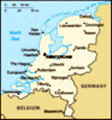Advertisement
Published: November 8th 2013
Rotterdam in the Netherlands 6 November 2013 After leaving Belgium, we travelled north, back into The Netherlands (Holland) and drove through Rotterdam. We didn’t stop but we could see that the city revolved around the old Oudehaven Harbour. There were many large bridges and a tunnel that went under the Rhine River. This is where the Rhine meets the North Sea.
This is also where many of the goods being transported from European countries, leave for around the world.
We wanted to go up the elevator of the highest building in Rotterdam, the Euromast, which is 185m high and built in 1960, but as we arrived in the city, the rain really set in and visibility would have been minimal.
We decide that it wasn’t worth stopping so we drove onto The Hague (Haag in Dutch).
The Hague, in the Netherlands 6 & 7 November 2013 We arrived in The Hague at about 3.30pm and it was still raining. After booking into the Camping Vakantiepark Kijkduin, we drove back into the CBD as we wanted to visit theDe Haagse Markets which was only operating Monday, Wednesdays, Fridays and Saturdays. It was Wednesday.
This market has over 500 stalls of food, clothes and knickknacks. When we got there, we walked from one end to the other end. The line of stalls seamed to go on forever. We stopped and talked to one of the stall holders who told us November and December are wet months which go into snowing months. After looking around until it closed, we went back to the camp site.
It was a 4 star camp site, with restaurant and large supermarket. We had dinner at their restaurant. I had a mixed grill (which fortunately, Tom helped me eat) and Tom had a beautiful salmon dish.
The next morning, we drove into The Hague, first stopping off at the Stadswandeling City Beach. The sea was a little grey but we could see that it would be ‘buzzing’ in summer.
We think The Hague is one of the most interesting cities in Europe. For starters, the name of the city starts with “The”, which sounds oh so authoritative and dignified. But much more importantly of course, The Hague is the third-most populous city in the Netherlands and the seat of the national government.
While Amsterdam is the official capital and undisputed tourist focal point in the country, The Hague is the foreign embassy home of the Netherlands, the judiciary capital of the United Nations and last but not least, the place where King Willem-Alexander hangs his hat.
Throw in a vibrant ethnic populace and the city of more than half a million people – not to mention a metro population of over 1 million – is a real gem. The Hague has a long history (the city’s name means “Count’s Wood” and dates back to the 13th century, when The Hague was the private asylum of the Count of Holland) and we saw many superb points of interest during our time there.
1. Panorama Mesdag The Hague School was a prolific period of Dutch artistic expression that ran for the last four decades of the 19th century. Maritime painter Hendrik Willem Mesdag was one of the most notable contributors to the era. The Hague has two museums in his honour in the Museum Mesdag and Panorama Mesdag. Both are wonderful cultural landmarks in the city but the latter contains Mesdag’s most famous creation in the
enormous Cyclorama known simply as the Panorama. At 14 metres high and 120 metres in circumference, the Panorama Mesdag is one of the biggest paintings in the world.
From an observation gallery in the centre of the room the cylindrical perspective creates the illusion that the viewer is on a high sand dune overlooking the sea, beaches and village of Scheveningen in the late 19th century. A foreground of fake terrain around the viewing gallery hides the base of the painting and makes the illusion more convincing.
We learnt, from a 20
2. Madurodam We then drove 2 kms and visited the Madurodam which is yet another prominent Scheveningen attraction. The miniature village replicates famous Dutch monuments and architecture on a tiny scale and is one of the most famous points of interest in The Hague. It also included models of power stations, the Amsterdam airport, the lock system in the canals, a cheese factory and a tulip production facility…all in miniature. Fascinating!
We then drove closer to the centre of the city, parked the car and then walked into the centre.
3. Noordeinde Palace We walked to one
of the Dutch monarchy four royal palaces in The Netherlands. The Hague’s Noordeinde Palace dates back to the early 16th century, when it was a medieval farmhouse. Today the palace is the official workplace of King Willem-Alexander and while not fully accessible to visitors; the magnificent gardens are open so we visited them.
We then walked around the CBD, across canals, looking in little shop windows and stopped to ask directions and chat to a couple of locals.
4. The Peace Palace The Hague’s Peace Palace (Vredespaleis), which was the next spot to visit, is perhaps the most recognizable landmark in the city. The palace serves many functions but is most famous as the seat of international law. The home of the “World Court” is a beautiful Neo-Renaissance edifice, with many fine interior details.
We then walked back to our car and drove past The Hague Stadium which was built in 2007, and is a small yet spectacular multi-purpose stadium and home to ADO Den Haag football club.
It was 4.00pm so we headed for Amsterdam which was 58km away. The road was fantastic. As we drove
out of The Hague, we drove under car parks and modern buildings which were built over the freeway. Very special!
Advertisement
Tot: 0.211s; Tpl: 0.017s; cc: 15; qc: 22; dbt: 0.1408s; 1; m:domysql w:travelblog (10.17.0.13); sld: 1;
; mem: 1.2mb






















